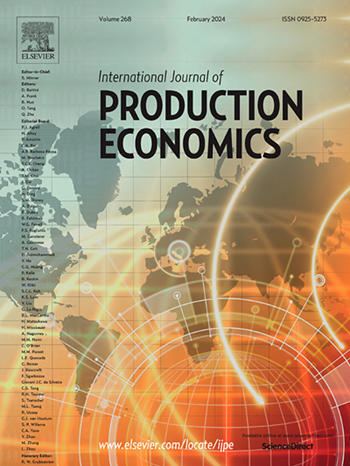A metric for the asymmetry in matched-pair data for buyer–supplier dyads
IF 10
1区 工程技术
Q1 ENGINEERING, INDUSTRIAL
引用次数: 0
Abstract
Although various difference-based methods are utilized to analyze asymmetry in buyer–supplier matched-pair data within the literature, these approaches are ad hoc and do not always address differences across multiple dimensions. Furthermore, they do not provide a significance test. This paper extends the concept of the paired t-test for dyad-level differences by developing a Mahalanobis distance-based metric in multiple dimensions, along with a significance test. The metric and the significance test can be used in empirical research to identify dyads in a dataset that are significantly asymmetric at any selected confidence level. In practice, the method can identify those suppliers for a buyer that have significantly mismatched expectations relative to other suppliers. The paper utilizes simulated datasets to compare the proposed metric with other distance-based metrics that lack a significance test. Finally, the paper applies a retail dataset to demonstrate (1) the utility of the metric in identifying significantly asymmetric dyads and (2) the use of the same distance concept to consolidate multiple items in any buyer or supplier construct into a single score for the construct, rather than using factor scores. The latter approach is lossless, in contrast to factor analysis. Using distance-based metrics with this retail dataset in a structural equation model suggests that asymmetry can negatively affect relationship-specific operational performance for buyers and suppliers. This study contributes a robust methodological framework, offering a structured basis for future research in the measurement of dyadic asymmetry.
买卖双方配对数据不对称的度量
尽管文献中使用了各种基于差异的方法来分析买方-供应商匹配对数据中的不对称性,但这些方法是临时的,并不总是解决跨多个维度的差异。此外,它们没有提供显著性检验。本文通过在多个维度上开发基于马氏距离的度量,以及显著性检验,扩展了成对t检验的概念。度量和显著性检验可以在实证研究中使用,以识别数据集中在任何选定的置信水平下显着不对称的二元。在实践中,该方法可以识别出那些相对于其他供应商有明显不匹配期望的供应商。本文利用模拟数据集将所提出的度量与缺乏显著性检验的其他基于距离的度量进行比较。最后,本文应用零售数据集来证明(1)该度量在识别明显不对称的二元组合方面的效用;(2)使用相同的距离概念将任何买方或供应商结构中的多个项目合并为该结构的单个分数,而不是使用因子得分。与因子分析相比,后一种方法是无损的。在结构方程模型中对零售数据集使用基于距离的度量表明,不对称会对买家和供应商的特定关系运营绩效产生负面影响。这项研究提供了一个强大的方法框架,为未来测量二元不对称的研究提供了一个结构化的基础。
本文章由计算机程序翻译,如有差异,请以英文原文为准。
求助全文
约1分钟内获得全文
求助全文
来源期刊
CiteScore
21.40
自引率
7.50%
发文量
266
审稿时长
52 days
期刊介绍:
The International Journal of Production Economics focuses on the interface between engineering and management. It covers all aspects of manufacturing and process industries, as well as production in general. The journal is interdisciplinary, considering activities throughout the product life cycle and material flow cycle. It aims to disseminate knowledge for improving industrial practice and strengthening the theoretical base for decision making. The journal serves as a forum for exchanging ideas and presenting new developments in theory and application, combining academic standards with practical value for industrial applications.

 求助内容:
求助内容: 应助结果提醒方式:
应助结果提醒方式:


